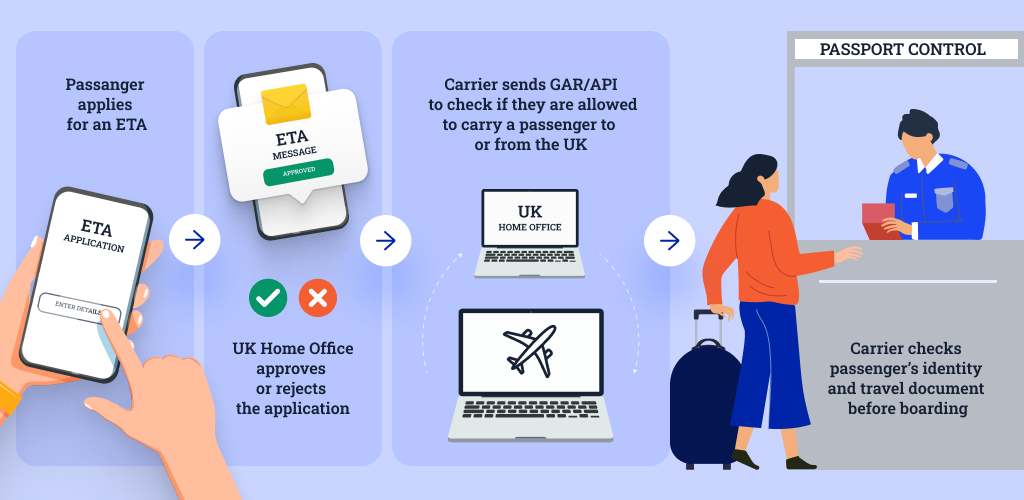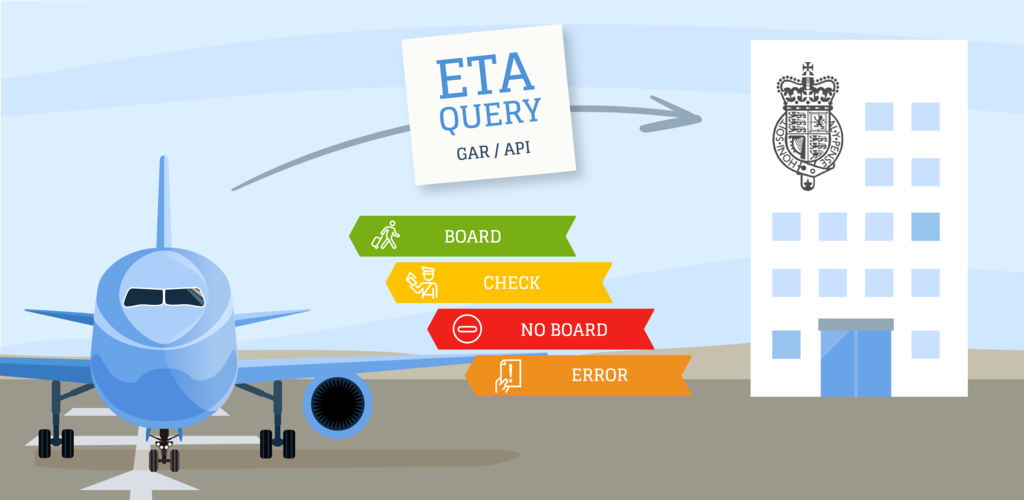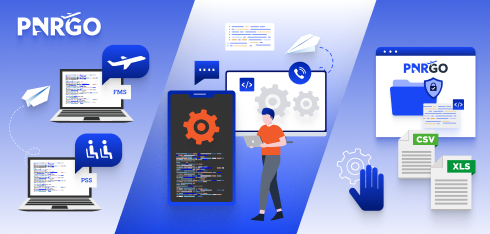The UK plans to fully implement its Universal Permission to Travel (UPT) scheme by 2025. In consequence, the first UK ETAs are coming into force on 15 November 2023. Under a new Carrier Liability Scheme, air operators will be obliged to check immigration permissions for non-visa nationals (in addition to visa nationals). This will affect both GAR and API submissions.
With ESTA in the States, eTA in Canada, and ETIAS coming soon in the European Union, the introduction of Electronic Travel Authorisation in the United Kingdom comes as no surprise. What does ETA mean and how can carriers prepare for the upcoming changes?
- [UPDATED] Transitional period: from 15 November until full enforcement
- Part of the bigger picture: Universal Permission to Travel
- Who and when: The scope of the UK ETA
- New ETA: What does it mean for carriers?
- Is there an easy way to automate the UPT / ETA process for carriers?
-------------------UPDATED 27.11.2023-------------------
Transitional period: from 15 November until full enforcement
During a phased rollout of ETA, there will be a ‘grace period’ when non-visa nationals will still be able to travel to the UK even if they do not hold an ETA. The full ETA enforcement is estimated around the end of 2024, with the exact date to be confirmed. What are carriers expected to do now?
| Passenger case scenario | Action for the carrier |
| Passenger has a Visa or Biometric Resident’s Permit | Verify the visa vignette or check the validity of the Biometric Resident’s Permit (a valid visa or Biometric Resident’s Permit is still recognized as a travel permission, just like ETA) |
| Passenger has an ETA | OK to board |
| Passenger is still waiting for their ETA application to be approved | OK to board |
| Passenger did not apply for an ETA | Ask them to apply before boarding |
| Passenger/UK confirms that the ETA has been rejected or cancelled | Do NOT board |
It is also important to know that carriers must continue to check the passenger’s identity and travel document (ETA changes do not affect these checks in any way).
---------------------END OF UPDATE---------------------
Part of the bigger picture: Universal Permission to Travel
ETA is a digital record linked to a person’s passport (valid for 2 years, or less if the passport expires). It is being introduced as part of a broader scheme called Universal Permission to Travel. The general aim of UPT is to strengthen the UK border security by ensuring that all travellers have a valid travel permission in advance. The plan is for the majority of these permissions to become digital-only in the future (e.g. e-visas). This way, carriers will be able to check and confirm a passenger's permission prior to travel. This will reduce the number of people denied entry at the border, and the associated detention and removal costs (which carriers need to bear).
Who and when: The scope of the UK ETA
In general, the UK ETA applies to visa-exempt passengers and those who do not have a UK immigration status. There will be some limited exceptions for those who cannot be required to hold a permission, e.g. diplomats.
ETA will NOT be required for people with either:
- a British or Irish passport;
- permission to live, work, or study in the UK;
- OR a visa to enter the UK.
People living in Ireland who are not Irish citizens will only be exempt if: they are legally resident in Ireland, do not need a visa to enter the UK, AND they are entering the UK via the Common Travel Area. All three conditions must be met.
The launch of ETA will be gradual. It is expected to have three phases, with the dates for the first two already announced:
- From 15 November 2023: the nationals of Qatar.
- From 22 February 2024: the nationals of Bahrain, Jordan, Kuwait, Oman, Saudi Arabia, and the UAE.
- Date TBC: more nationalities – including the nationals of EU, USA, and Australia
New ETA: What does it mean for carriers?
The introduction of ETA has affected the Authority to Carry regulations, which constitute the UK’s “no fly” scheme. Travellers who are refused an ETA, as well as those whose ETA gets cancelled, are now included on the list of people whom carriers cannot carry to or from the UK.
A carrier may suffer a penalty of up to £50,000 when:
- they do not check if they can carry a person;
- they carry a person who has no valid permission to travel.
This means that – once the UK systems are fully set up – carriers will need to send their API data in an 'interactive' way in order to check the ETA status (the submissions will trigger a response from the Home Office). There are different ways to meet this requirement (depending on the type of operation and terminal type):
- submitting GAR data manually via the sGAR web-portal;
- submitting API data from DCS via the UK iAPI system;
- requesting a third-party (e.g. your Ground Handler / FBO / Data Provider) to submit the data on your behalf.
How ETA affects your manual GAR submissions
There have been two ways to submit your GAR until now - via the sGAR web user interface or via email. Next year, the GAR submissions will only be possible by using the sGAR interface, and the XLS email submissions will no longer be accepted. The sGAR system will show whether the passenger has a valid travel permission or not.
How ETA affects your API submissions
The UK iAPI system will be updated with new CUSRES codes to return the ETA responses. The legacy batch API is deprecated.
ETA status check: four possible outcomes
Regardless of the submission method, there will be four basic results (board / check / no board / error), with additional codes or descriptions for carriers to know what needs to be done:
- BOARD: A valid permission to travel has been found. Once the identity and passport / travel document check is completed, the passenger can board the plane.
- CHECK: There is no record of a valid permission to travel. The carrier has to conduct a manual check of immigration or exemption documents as well as identity checks. If the check is satisfactory, the passenger may board.
- NO BOARD: The permission to carry is refused. The person must not board the plane. Carrying such a passenger entails a risk of a civil penalty.
- ERROR: The permission to travel cannot be confirmed due to some missing data. The carrier should correct the data, resend it, and wait for the check result.
Is there an easy way to automate the UPT / ETA process for carriers?
Yes. PnrGo offers two independent connections with the Home Office to enable UPT / ETA passenger validation for all air operators. We can help you submit your GAR or API data in an interactive and automated way, keeping your business compliant effortlessly. Our solutions are very flexible and can be adjusted to your operational preferences – from plugging directly to your Flight Scheduling Software to semi-automated XLS integrations.
PnrGo has been trusted by over 150 air operators with their PAX and CREW data transfers. If you are interested in the services we offer, feel free to schedule a call with our team.





















